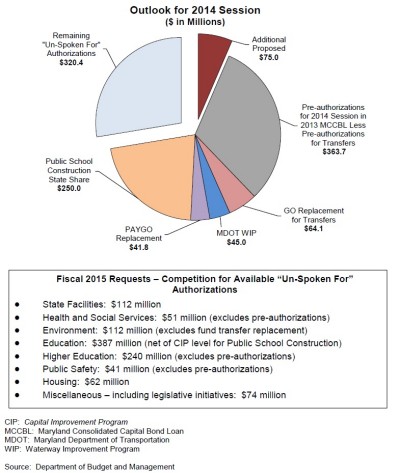
ANNAPOLIS—The legislature’s fiscal staff told lawmakers Thursday, Nov. 14, that they should not follow an O’Malley administration proposal to increase Maryland’s authorized debt by $375 million over the next five years.
The staff said this is one way to reduce debt service — payments of principal and interest on the state’s bonds — that will grow by 24% in those five years. It would be the largest increase in any budget category.
“Debt service is a major influence on everything else,” said Warren Deschenaux, fiscal and policy director for the Department of Legislative Services. Debt service grows from $233 million in fiscal 2015 to $557 million in fiscal 2019, according to a briefing paper (p. 32).
This will prevent funding any major new initiatives, such as preschool for all children, as proposed by Democratic candidates for governor, including Lt. Gov. Anthony Brown.
The debt service drain on the budget presumes the Board of Public Works — the governor, state treasurer and comptroller — remains unwilling to raise the state’s property tax which is dedicated to paying off bonds. That is currently set at 11.2 per $100 of property valuation.
Spending limits to be set next month
Deschenaux and his staff were testifying before the legislature’s Spending Affordability Committee, a collection of legislative leaders which will recommend spending limits to the governor next month.
Last month, Deschenaux told the committee that that the structural deficits they thought they had largely cured in this year’s budget had returned, with a projected $400 million shortfall next year.
In a question that suggested some leaders are looking at other ways to reduce capital debt, House Speaker Michael Busch asked the staff if they had ever looked at adjusting the amount of capital dollars given to counties for school construction as a way to bring debt service under control. Deschenaux said they had not.
The state currently allocates $250 million to $350 million every year for public school construction and renovation, a quarter to a third of the $1.1 billion in new bonds the state is selling each year. Any cut in such funding would further upset county officials who have been forced to take on more expenses for highway maintenance and teacher pensions as the state sought to balance its budget by offloading expenses.
Bonds used to replace cash in dedicated programs
The legislative staff said that over the last five fiscal years, including fiscal 2014, $1.4 billion in general obligation bonds — making up 25% of the authorized debt — “has been used as a source of replacement funding” for transfers of cash from programs usually funded by dedicated taxes for capital projects, such as Program Open Space and the Chesapeake Bay Restoration Fund.
Because of school construction, pre-authorized capital projects and replacement transfers, the state will only have about $320 million to spend on new projects next year, compared to $1.1 billion in requests from various state agencies, universities and school systems.
The O’Malley administration pushed hard in September for an increase of $75 million in bond authorization every year for the next five years. The Capital Debt Affordability Committee approved the request over the strong objections of Comptroller Peter Franchot, who was outvoted 4-1 by State Treasurer Nancy Kopp, O’Malley’s budget and transportation secretaries, and the public member of the debt committee.
The legislature can reject that debt level if it goes along with its own staff recommendation.
“I’m sort of in favor of that,” said Sen. Ed Kasemeyer, chairman of the Budget and Taxation Committee, giving his immediate reaction to the briefing.


